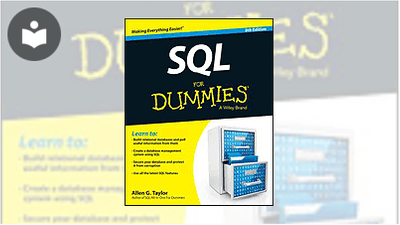SQL for Dummies, 8th Edition
- 7h 10m
- Allen G. Taylor
- John Wiley & Sons (US)
- 2013
Uncover the secrets of SQL and start building better relational databases today!
This fun and friendly guide will help you demystify database management systems so you can create more powerful databases and access information with ease. Updated for the latest SQL functionality, SQL For Dummies, 8th Edition covers the core SQL language and shows you how to use SQL to structure a DBMS, implement a database design, secure your data, and retrieve information when you need it.
- Includes new enhancements of SQL:2011, including temporal data functionality which allows you to set valid times for transactions to occur and helps prevent database corruption
- Covers creating, accessing, manipulating, maintaining, and storing information in relational database management systems like Access, Oracle, SQL Server, and MySQL
- Provides tips for keeping your data safe from theft, accidental or malicious corruption, or loss due to equipment failures and advice on eliminating errors in your work
Don't be daunted by database development anymore - get SQL For Dummies, 8th Edition, and you'll be on your way to SQL stardom.
About the Author
Allen G. Taylor is a 30-year veteran of the computer industry. He lectures nationally on databases, innovation, and entrepreneurship, and teaches database development internationally through a leading online education provider. He has written more than 20 books, including all editions of SQL For Dummies.
In this Book
-
Introduction
-
Relational Database Fundamentals
-
SQL Fundamentals
-
The Components of SQL
-
Building and Maintaining a Simple Database Structure
-
Building a Multitable Relational Database
-
Manipulating Database Data
-
Handling Temporal Data
-
Specifying Values
-
Using Advanced SQL Value Expressions
-
Zeroing in on the Data You Want
-
Using Relational Operators
-
Delving Deep with Nested Queries
-
Recursive Queries
-
Providing Database Security
-
Protecting Data
-
Using SQL within Applications
-
Accessing Data with ODBC and JDBC
-
Operating on XML Data with SQL
-
Stepping Through a Dataset with Cursors
-
Adding Procedural Capabilities with Persistent Stored Modules
-
Handling Errors
-
Triggers
-
Ten Common Mistakes
-
Ten Retrieval Tips



